Constantine V › Constantine VII › The Bronze Bells of Ancient Korea » Origins and History
Articles and Definitions › Contents
- Constantine V › Who Was
- Constantine VII › Who Was
- The Bronze Bells of Ancient Korea › Origins
Ancient civilizations › Historical places, and their characters
Constantine V › Who Was
Definition and Origins
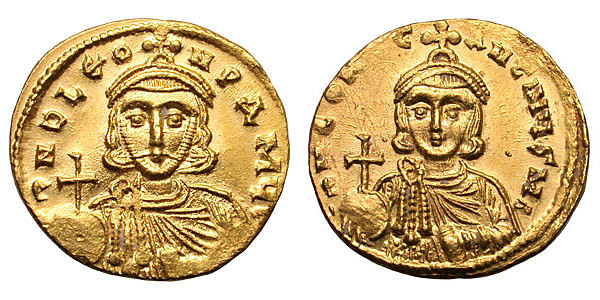
Constantine V, also known as Constantine the Dung-named by his enemies, was emperor of the Byzantine empire from 741 to 775 CE. He enjoyed military successes in the Middle East and Balkans but his reign is chiefly remembered for his systematic persecution of any Christians, churches and monasteries which venerated icons, idols and relics. These actions and a neglect of affairs in Italy would, ultimately, see the Popes break from the Byzantine empire and join with the Franks, splitting the Christian Church in two.
EARLY LIFE & FAMILY
Constantine was born in 718 CE as the son and successor to Emperor Leo III, a Syrian diplomat under Justinian II who had gone on to found the Isaurian dynasty which lasted until 802 CE. Constantine was crowned co-emperor with his father in 720 CE. In 732 CE he married Irene, the daughter of the Turkic tribal leader Khazar khan, although, following her premature death, the emperor would marry twice more.
Constantine had seven children in all and the birth of his first, his son Leo, would give rise to the oft-used expression, “to be born in the purple” or porphyrogennetos. The phrase derived from the porphyry, a rare purple-laced marble, that was used in the chamber of the palace at Constantinople where Leo's birth, and many subsequent ones, took place. The restriction that only royalty wore robes made with Tyrian purple dated back to Roman times and this new tradition was one more attempt to further reinforce the legitimacy of dynastic succession and deter would-be usurpers. An additional tool was Constantine's insistence that all officials swear an oath of allegiance to the royal person and heir.
ARTABASDOS THE USURPER
Constantine's reign got off to the worst possible start when Artabasdos seized control of the capital Constantinople in 742 CE.Artabasdos was the military governor ( strategos ) of the Armeniakon region in north-east Asia Minor, the second most important military province, or theme, in the empire. He was also Constantine's brother-in-law. Artabasdos was supported in his claim to the throne by Anastasios, the Patriarch of Constantinople (the Bishop), chiefly because the usurper restored the veneration of holy icons which the Church was so keen on and Constantine was so against.
CONSTANTINE SET ABOUT BEAUTIFYING HIS CAPITAL & RESTORING IT TO ITS FORMER GLORY BOTH IN ARCHITECTURE & COMMERCE.
Constantine moved his army against the rebels, first in the province of Opskikon and then Armeniakon. Next, he liberated Constantinople and so was able to regain his throne in 744 CE. The emperor then set about punishing those who had wronged him. Anastasios was not removed from office but was publicly whipped and sent naked through the streets of the capital riding backwards on a donkey. Artabasdos faired rather worse, he was blinded along with his two sons in a public ceremony in the capital's Hippodrome.
Constantine set about beautifying his capital and restoring it to its former glory both in architecture and commerce. He oversaw the rebuilding of the city ’s main aqueduct (originally built by Valens), the restoration of the Church of St. Irene, had new churches built such as the Pharos Church in the palace grounds, and rejuvenated the city's marketplaces.
ICONOCLASM
As already mentioned, Constantine was a staunch opponent of the use of religious images in Christianity, just like his father before him, and he campaigned relentlessly for their destruction. For the emperor, only the Eucharist was the true image of Christ. Such was his fervour in iconoclasm (the destruction of icons and holy representations) he wrote treatises on the subject and chaired a conference of like-minded Church figures at Hieria, a suburb of Constantinople, in 754 CE. The council included 338 bishops but representatives from the pro-icon sees of Jerusalem, Antioch and Alexandria were not invited. The result was a declaration that the iconoclast position was the new orthodoxy. The historian TE Gregory here summarises the theological problems the issue of icons raised and why some were so against them:
Under Constantine V, Iconoclast theologians began to see connections with the theological disputes of the past 400 years: they argued that images, in fact, raised once again the Christological problems of the fifth century. In their view, if one accepted the veneration of ikons of Christ, one was guilty of either saying that the painting was a representation of God himself (thus merging the human and the divine elements of Christ into one) or, alternatively, maintaining that the ikon depicted Christ's human form alone (thus separating the human and the divine elements of Christ) - neither of which was acceptable. (212)
From 755 CE a harsh persecution of iconophiles began, led by such zealous officials as Michael Lachanodrakon, strategos of Thrakesion. Monasteries were especially targeted, with the state seizing property and Michael infamously burning down the Pelekete monastery on Mt. Olympus. Churches were hit, their precious icons and relics destroyed, and any imagery deemed unsuitable defaced - in some cases in the capital by Constantine himself - or replaced with depictions of crosses or landscape scenes. The only symbol of worship permitted was the True Cross, the wooden remains of which were in Constantinople at that time. Individuals, too, suffered and not just those in the Church but also the army and bureaucracy. Mutilations, stonings and executions were carried out on those who did not toe the line, the most infamous being of St. Stephen. Constantine was also said to have involved himself in these punishments, smearing oil on the beards of unrepentant monks and setting them on fire.
A RUMOUR WAS SPREAD THAT WHEN CONSTANTINE HAD BEEN BAPTISED AS A BABY HE HAD DEFECATED INTO THE BAPTISMAL FONT.
Many in the Church were very keen on their icons, though, and the emperor became deeply unpopular - so much so, a rumour was spread that when Constantine had been baptised as a baby he had defecated into the baptismal font. The emperor thus acquired his inglorious nickname of Kopronymos or “named in dung”. The emperor's reputation was similarly sullied by rumours that he was a harp-playing bisexual when in the privacy of his palace. Many art lovers past and present, no doubt, would likewise take Constantine's name in vain for all the beautiful religious art lost to posterity by his destructive zeal.
MILITARY CAMPAIGNS
Once Constantine had made his throne safe following the Artabasdos rebellion and reorganised his army into six new regiments ( tagmata ), he set about expanding the empire. The historian JJ Norwich here summarises his martial abilities,
He was a courageous fighter, a brilliant tactician and leader; of all his subjects, it was his soldiers who loved him most. (114)
First, Constantine took on the Arab world. Between 746 and 752 CE the emperor enjoyed many successes in northern Syriaand Armenia, not a little helped by the civil war in, and ultimate collapse of, the Umayyad Caliphate with its capital at Damascus. The Umayyad were replaced by the Abbasid dynasty who promptly moved their capital to the safer distance of Baghdad. Peace was made with the Arabs in 752 CE.
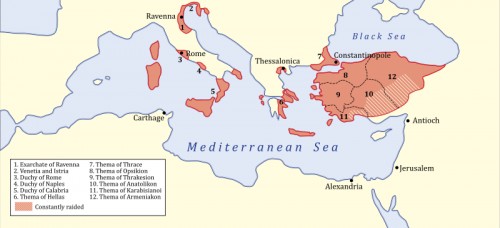
Byzantine Empire, 717 CE
Perhaps Constantine should have kept a more careful watch on the western half of his empire for in 751 CE the Lombardsconquered Ravenna which, as an exarchate (semi-autonomous region), had acted as a protector of Byzantine interests in Italy.The defeat, along with Constantine's increasing ties with Pepin the Short (king of the Franks), the emperor's relentless persecution of icons and the decision to move Italy, Sicily and the southern Balkans away from Papal authority and put them under that of the Bishop of Constantinople, led the Popes in Rome to begin looking elsewhere for an ally, notably the Franks and Charlemagne.
In 756 CE Constantine did turn his attention to the west and the Bulgars who had long been making trouble in the Balkans. As with his predecessors and successors, though, the Bulgars proved a stubborn enemy to defeat completely. A successful campaign in 759 CE was followed by two big victories against Khan Telerig (rc 770-777 CE) in 773 CE, the Battle of Anchialos being especially significant in reducing Bulgar influence in Thrace. However, these did nothing to quell Bulgar ambition and the emperor twice lost fleets in storms. Constantine was still fighting them when he died of illness on campaign in 775 CE. His first son then fulfilled his purple destiny and succeeded his father as emperor Leo IV, having already been crowned co-emperor in 751 CE.
The memory of Constantine V was deliberately darkened by the Church whose icons he had so zealously attacked but this had little effect on his popularity with ordinary people during his reign. It was a popularity that withstood such disasters as the devastating Bubonic plague which hit the empire in 747 and 748 CE, wiping out a third of the population. The standard of living in Constantinople, especially, improved under his guidance and the people had access to plentiful food at reasonable prices.The emperor was also a gifted military commander, as not only his victories illustrate, but also in the famous, perhaps staged, action of a desperate mob who broke into his tomb in the Church of the Holy Apostles to plead for him to rise from his sarcophagus and bring back much-needed victories to the failing empire of the early 9th century CE. There may well have been greater Byzantine rulers over the centuries who now command more lines in the history books but few could match the passion in their beliefs that this most learned of emperors applied to his reign.
Constantine VII › Who Was
Definition and Origins
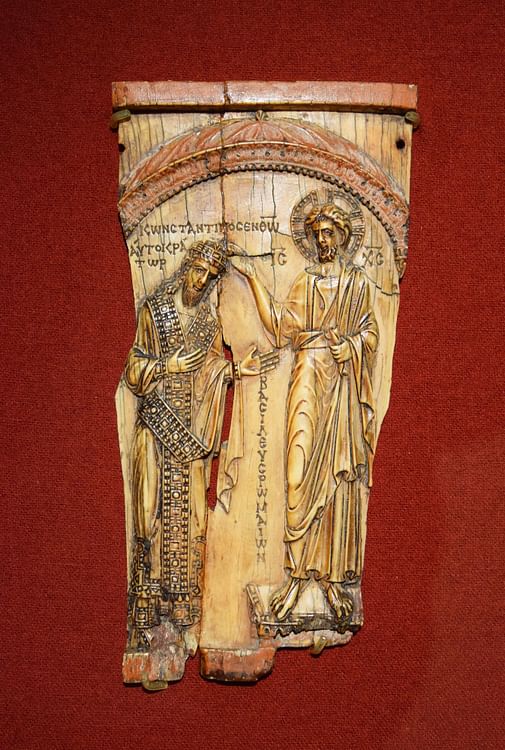
Constantine VII was Byzantine emperor from 945 until 959 CE. Sometimes known as Constantine Porphyrogennetosbecause of his birth in the purple chamber of the royal palace, he was served by various regents from 912 CE until reigning in his own right after a 33-year wait. Known for his prolific writing and as a sponsor of literature and the arts, the emperor's reign was a successful one and included notable victories against the Arabs in Mesopotamia.
SUCCESSION & REGENTS
Constantine was born in 906 CE; his mother was Zoe Karvounopsina, fourth wife of emperor Leo VI (886-912 CE). As such, the emperor was a member and fourth ruler of the Macedonian dynasty founded by Basil I (r. 867-886 CE). Constantine, as was the tradition, had already been crowned co-emperor by his father in 908 CE, and when Leo died on 11 May 912 CE, his only male heir, Constantine VII, took the throne just a few days shy of his eighth birthday.
Constantine VII, like his father Leo VI, was “born in the purple” or porphyrogennetos. The phrase derived from the porphyry, a rare purple-laced marble, that was used in the chamber of the palace at Constantinople where Leo's birth, and many subsequent ones, took place. The restriction that only royalty wore robes made with Tyrian purple dated back to Romantimes, and this new tradition was one more attempt to further reinforce the legitimacy of dynastic succession and deter would-be usurpers. With many regents and pretenders to his throne, Constantine's claim to legitimacy would prove a very valuable one indeed.
THE BYZANTINE EMPIRE WAS REGAINING SOME OF ITS LOST LUSTRE & CONSTANTINE'S COURT BEGAN TO ATTRACT DIGNITARIES EAGER TO SEE FOR THEMSELVES THIS LEARNED YOUNG EMPEROR.
Because of his young age, Constantine's uncle Alexander acted as his regent. Alexander, a drunken roisterer infamous for his cruelty and debauched lifestyle, died in 913 CE while performing pagan sacrifices in the Hippodrome of Constantinople. It was just as well for the young Constantine as Alexander had boasted he would have the boy castrated. Constantine's next regent was Nicholas I Mystikos, the Patriarch (bishop) of Constantinople, with one of Nicholas' first acts being to dismiss his rival the emperor's mother to a convent. Zoe was shorn of her hair and henceforth would only be known as Sister Anna. Although a revolt led by the usurper Constantine Doukas was quashed, the bishop proved inadequate in responding to the threat of Symeon, Tsar of the Bulgars, who was as troublesome now as he had been during Leo VI's reign. Symeon's armies were almost at the gates of Constantinople, and the reeling empire was obliged to meet his peace terms which included marrying his daughter to Constantine VII.
A faction of the Byzantine court baulked at the idea of merely handing over power to the Bulgar emperor and staged a coup d'etat. Consequently, in February 914 CE, Constantine's mother returned from the political wilderness, called off the proposed marriage alliance and acted as her son's third regent. Zoe, although enjoying some military success against the Arabs, turned out to be just as ineffectual in staving of the Bulgars' renewed attacks in the Balkans and Greece, and she was forced to step down in 919 CE, undergo another haircut and retreat back to her nunnery. Romanos I Lekapenos, commander of the Byzantine navy, took his chance and became regent number four in 920 CE. He enjoyed certain successes against the Arabs in Mesopotamia, capturing Melitene, Nisibis, Dara, Amida, Martyropolis, and Edessa. To cement his position, Romanos had his daughter Helena marry Constantine, had himself crowned co-emperor and declared senior to Constantine, and then even had his three sons crowned as co-emperors.
Romanos may have initially been planning to found a new dynasty of his own, but the project was practically sunk when his eldest and most capable son, Christopher, died in 944 CE. The co-emperor's other sons were too young and useless, and it seems likely their father planned to at last release the throne to its rightful occupant, Constantine VII. Romanos had, after all, a stake already in the Macedonian dynasty now that his daughter was empress. However, Romanos' two remaining sons had other plans and themselves staged a coup in 944 CE in which they exiled their father to a monastery. Fortunately for Constantine, there was significant support at court to return the throne to the legitimate line of descent, and the Romanos boys were kicked out of Constantinople on 27 January 945 CE. Constantine could finally take the throne in his own right, aged 39: it was better late than never.
LAND REFORMS
Constantine continued the agrarian reforms of Romanos I and sought to rebalance wealth and tax responsibilities, thus, the larger estate owners ( dynatoi ) had to return lands they had acquired from the peasantry since 945 CE without being given any compensation in return. For land acquired between 934 and 945 CE, the peasants were required to repay the fee they had received for their land. The land rights of soldiers were likewise protected by new laws. Because of these reforms “the condition of the landed peasantry - which formed the foundation of the whole economic and military strength of the empire - was better off than it had been for a century” (Norwich, 183).
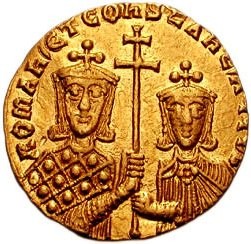
Constantine VII & Romanos II
MILITARY CAMPAIGNS & DIPLOMACY
Constantine's foreign exploits usually saw him face the now familiar enemy of the Arab Caliphate as, fortunately for the Byzantines, Symeon the Bulgar had now been succeeded by the more accommodating Peter and a peace treaty was signed eliminating that particular enemy of the empire. 949 CE saw a failed attempt to take Crete, but Germanikeia on the Mesopotamian frontier was captured the same year. In 953 CE Germanikeia was lost again, but several victories came in the following years, thanks to the able generals Nikephoros II Phokas and John I Tzimiskes, both of whom would be future emperors. Nikephoros, particularly, enjoyed such successes that he became known as the “Pale Death of the Saracens” and even a rumour of his army merely mobilising caused the Arabs to retreat. In 958 CE Tzimiskes led a force which captured the strategically important Samosata on the upper Euphrates river.
The Byzantine Empire was regaining some of its lost lustre and Constantine's court began to attract dignitaries eager to see for themselves this learned young emperor who had set Constantinople back on its feet. The historian L. Brownworth makes the following comments on the diplomatic sparkle Constantine showered on his visiting peers from foreign powers:
Dignitaries and ambassadors from the caliph of Cordoba to the crowned heads of Europe came flocking to Constantinople, where they were dazzled with the breadth of the emperor's knowledge and the splendor of his court. Entertained in the sumptuous palace known as the Hall of the Nineteen Couches, visiting guests would recline to eat in the ancient Roman fashion, clapping in wonder as golden plates laden with fruit would be unexpectedly lowered from the ceiling. Cleverly concealed cisterns would make wine splash from fountains or cascade down carved statues and columns, and an automatic clock in the city ’s main forum would complete the imperial tour de force. Most impressive of all, however, was the emperor himself. (188)
LITERATURE & ARTS
Constantine VII gained a reputation as a great scholar, and we know he was a collector of books, manuscripts, and artworks, and an accomplished painter, too. His most famous written works are the De administrando imperio, a handbook for rulers and diplomats (especially aimed at his son and heir) which includes notes on the cultures bordering the empire, the Dethematibus, on the geography and history of the empire's various provinces, and the De ceremoniis on the protocols and ceremonies of the Byzantine court. Constantine drew on many earlier works, and his own thus preserve a rich Byzantine heritage, undaunted as he was by the task of sifting through the immense imperial archives, as he himself states in one of his books:
Research into history has become clouded and uncertain, either because of the scarcity of useful books or because the quantity of written material has aroused fear and dismay. (Herrin, 182).
The emperor sponsored the literary works of others, notably the Geoponika encyclopedia on agriculture and the catalogue of the Church of the Holy Apostles in Constantinople by his asekretis (imperial secretary), the poet Constantine of Rhodes.Another important commission was the Synaxarion, a comprehensive calendar of saints, each figure having a short biography.Constantine revived the Magnaura university within the royal palace, which had four chairs: philosophy, geometry, astronomy, and grammar. Historians were another group supported by the emperor, including such noted figures as Genesios and Theodore Daphnopates. One of the most important histories of the period is the anonymous Theophanes Continuatus, a chronicle of Byzantine rulers and events from 813 to 961 CE.
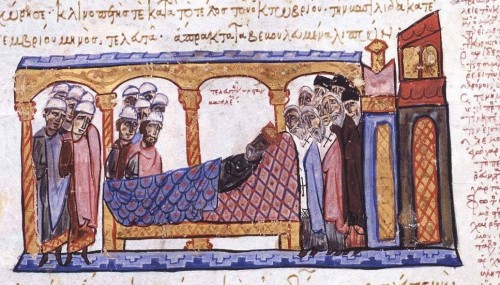
Dying Constantine VII
Constantine was especially keen not to have any tarnish spread to his own image from some of his more dubious predecessors in the Macedonian dynasty, especially its founder Basil. Consequently, he wrote the whitewashed biographical Vita Basilii which became the accepted historical record of Basil's life and achievements. Besides his own literature, Constantine also supported other arts, especially the production of illuminated manuscripts and carved ivories.
DEATH & LEGACY
Constantine's reign was a successful one, and he is remembered today as one of the more accomplished Byzantine rulers, as the historian JJ Norwich here summarises:
He was an excellent Emperor: a competent, conscientious and hard-working administrator and an inspired picker of men, whose appointments to military, naval, ecclesiastical, civil and academic posts were both imaginative and successful. He did much to develop higher education and took a special interest in the administration of justice. That he ate and drank more than was good for him all our authorities seem to agree; but there is unanimity, too, on his constant good humour: he was unfailingly courteous to everyone and was never known to lose his temper. (181)
When Constantine died of natural causes on 9 November 959 CE, he was succeeded by his 20-year old son with Helena Lekapenos, Romanos II. Unfortunately for Romanos, his reign would be a short one, and his throne passed to his two young sons Basil II, “the Bulgar-Slayer”, and Constantine VIII in 963 CE, who would continue the Macedonian dynasty for another half-century.
The Bronze Bells of Ancient Korea › Origins
Ancient Civilizations
The metalworkers of ancient Korea were highly skilled artists and some of their finest surviving works are the large bronze bells cast for use in Buddhist temples and monasteries. Both the Unified Silla kingdom and Goryeo kingdom produced bells, but perhaps the most famous example is the 19-ton Emille Bell from Pandok-sa which is considered one of the national treasures of Korea.
ORIGINS & FUNCTION
Bronze bells were first made in Korea in the Bronze Age, but these were small items of uncertain use. They were not musical and may have been added to horse trappings or used in shamanist ceremonies, perhaps even carried as a symbol of authority. Musical bells were introduced from China in 1116 CE, and these were part of the aak orchestra which accompanied Confucian rites and ceremonies. The most famous bells of Korea, though, are those large cast bells ( pomjong ) used in Buddhist temples and monasteries. These too had been introduced from China during the Tang dynasty, but as with other arts such as papermaking and ceramics, the Koreans outdid their teachers and produced exceptionally large and finely decorated examples.

Sangwonsa Bell
The large bronze bells of Korea did not have clappers as they were struck from the side using a horizontal wooden beam suspended by a rope. The bells themselves were suspended from the ceiling of a small purpose-built pavilion structure near the entrance to the temple. Large bells were rung to announce services at the beginning and end of each day while smaller bells heralded other services and rang out each hour.
SILLA BELLS
The largest and most famous bronze bells of Korea come from the Silla kingdom which had ruled south-east Korea from 57 BCE to 668 CE and then, as the Unified Silla Kingdom, the whole of the Korean peninsula until 935 CE. Metalwork had long been a fine Silla art, best seen in the gold crowns from various tombs and the gilded-bronze figurines and statues of Buddhist figures. The Unified Silla Period then saw a new art-form develop, that of making large bronze-cast bells which were hung in Buddhist temples.
THE DRAGON & LOOP ASSEMBLY ON THE CROWN OF KOREAN BELLS IS A UNIQUE COMBINATION OF CHINESE HANGING BELLS & HANDBELLS.
Like Chinese bells, there are four square decorative panels ( yugwak ) near the top, each with nine knobs ( ju ) set in three rows of three. Silla bells differ, though, from Chinese bells of similar purpose in that they have pairs of flying apsaras carved in relief - the female heavenly beings who attend Buddha - and a much more elaborate design for the suspension of the bell, most often in the form of an intricately carved dragon and short hollow post which possibly acted as a sounding tube. The dragon and loop assembly on the crown ( wu ) of Korean bells is, therefore, a unique combination of Chinese hanging bells ( chung ) and handbells ( t'o ).
Added decoration typically includes bands of floral designs at the base and top of the bell ( sangdae ), most often using a motif of honeysuckle or the pao - hsiang - hua flower. In addition, the bells have a large lotus rosette near the base where the beam strikes the bell and one rosette on the opposite side.
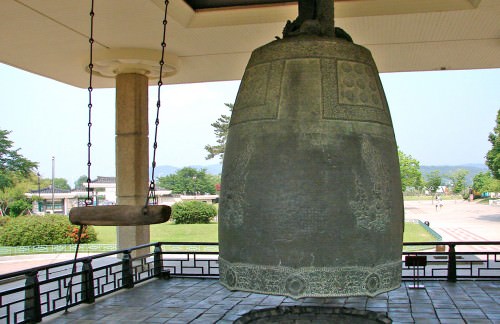
Korean Buddhist 'Emille' Bell
The oldest surviving bell comes from the Sangwonsa temple on Mt. Odae near Pyeongchang and dates to 725 CE. The bell is 1.67 metres tall with a diameter of just under a metre and was funded by one Hyudori, the wife of a local aristocrat. The bell's decoration includes a flute and two harp players, and a lotus medallion surrounded by honeysuckle.
The largest Silla bell is from Pandok-sa, also known as the Emille Bell, which was cast in 771 CE to honour King Seongdeok (r. 702-737 CE). An inscription on the bell informs us of the lengthy process needed to cast such giant bells. It states that the project was begun by Seongdeok's son King Kyeondeok but he died in 765 CE when it was still not ready so that his son Hyegong was left to finish the job. According to a legend in the 13th-century CE Samguk yusa, the task was so overwhelming the man responsible for casting the bell that he was driven to throw his own daughter into the molten bronze in the hope that her sacrifice would allow the bell to be finally made. The sound of the bell when rung is thought to echo the girl's despairing cry of emille ('Mother') as she was thrown into the bronze, hence its popular name.
A close examination of the surface of the bell reveals that the mould was made of several different pieces and there were ten pouring holes in the crown. Around 3.5 metres tall and 2.27 metres in diameter, it is decorated with lotus flowers and heavenly beings with the classic Silla suspension loop in the form of a dragon. Weighing almost 19 tons, the bell is now on display in the Gyeongju National Museum. Even the Pandok-sa bell would have been dwarfed, though, by some of the larger bells which have, unfortunately, not survived. One, the Hwangnyong-sa bell, is recorded as having weighed a massive 500,000 kun or over 300 tons.

Dragon Bell Suspension, Sangwonsa Temple
GORYEO BELLS
The Goryeo dynasty ruled Korea from 918 CE to 1392 CE and Buddhism continued to be the most important religion of the state. 70 bells from this period survive with 17 of them carrying dates, the earliest being 963 CE. Many examples are today in Japan, given as gifts by the Yi government or looted during the 16th-century CE Hideyoshi invasion. Goryeo bells are smaller than the giant bells made by the Silla kingdom but can still be up to 1.7 metres tall. They, too, were cast in bronze and decorated with dragons and heavenly figures, but now also Buddhas and bodhisattvas too. If anything, the Goryeo bells are more decorative than their predecessors with one example from the Naesco temple in south-west Korea (1222 CE) having lotus leaf petals protruding from the upper rim of the bell, a more elaborate border around the nine-nodule squares, and four spheres added to the dragon suspension loop. Perhaps the most outstanding Goryeo example is the 1.7 metre tall bell now at the Toksu Palace Museum of Fine arts in Seoul.
Bells must not have been particularly popular with the local peasant populace as they were often compelled by monasteries and temples to 'donate' their bronze goods so that they could be melted down and recast into bells. This is probably the origin of the Pulgasari monster of Korean folklore. His name means 'Buddhist Temple Dweller' and he was thought to have lived off bronze and iron which he melted with his red-hot body. He was especially fond of needles and promised to chase away other monsters if his appetite was satisfied. Handbells and temple gongs were also produced in metal for use in Buddhist monasteries, and these smaller works were often beautifully inlaid with very fine pieces of silver or gold.
LICENSE
Article based on information obtained from these sources:with permission from the Website Ancient History Encyclopedia
Content is available under License Creative Commons: Attribution-NonCommercial-ShareAlike 3.0 Unported. CC-BY-NC-SA License